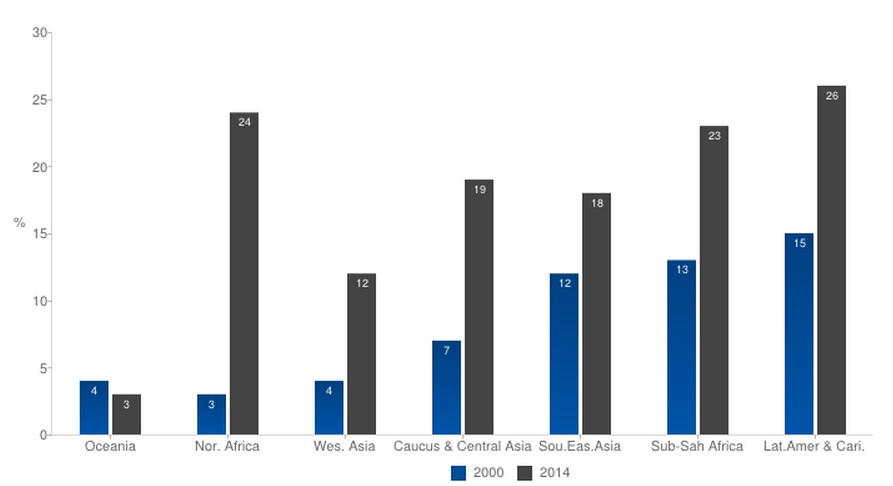8 recursos para valorar el grado de cumplimiento de los 8 Objetivos de Desarrollo del Milenio
8 recursos para valorar el grado de cumplimiento de los 8 Objetivos de Desarrollo del Milenio
October 23, 2014
Los Objetivos de Desarrollo del Milenio (ODM) son unas metas de desarrollo internacional que 192 países miembros de las Naciones Unidas y al menos 23 organizaciones internacionales acordaron cumplir para 2015. Queda bien poco para llegar a esta fecha: ¿en qué estado de cumplimiento se encuentran los 8 ODM?
En este artículo os queremos recomendar 8 recursos de la red para que puedas evaluar el grado de cumplimiento de los Objetivos del Desarrollo del Milenio.
ODM 1: Erradicar la pobreza extrema y el hambre.
La pobreza y el hambre continúan siendo una realidad en el mundo. La meta de los Objetivos del Milenio era reducir a la mitad, entre 1990 y 2015, el porcentaje de personas que viven con menos de 1 € al día. Es por ello que recomendamos ver el vídeo de Cruz Roja –dentro de su web con recomendaciones pedagógicas sobre los Objetivos del Milenio –titulado "Cómo se vive con menos de 1 € al día", donde diferentes niños de Nicaragua explican cómo es su día a día con este sueldo familiar.
ODM 2: Alcanzar la educación primaria universal.
Este objetivo pretende velar para que todos los niños y niñas puedan acabar un ciclo completo de educación primaria. Pese a que durante la década pasada se produjo un gran avance en este terreno –el porcentaje de menores escolarizados llegó al 90% en países en vías de desarrollo-, el progreso en la reducción de la cantidad de niños que no asisten a la escuela ha disminuido considerablemente. Para más detalles, podéis consultar este estudio del Programa de las Naciones Unidas para el Desarrollo (PNUD).
ODM 3: Promover la igualdad de género
Aquí la importancia radica en el empoderamiento y la capacidad de la mujer para participar en la política de su país. Según el PNUD, la participación continúa en aumento, impulsada por un sistema de cuotas. Un gráfico nos ayudará a ver esta evolución.
Proporción de escaños ocupados por mujeres en las cámaras (baja o unicameral) de los parlamentos nacionales, 2000 y 2014:
Leyenda: Fuente: Informe ODM 2014

ODM 4: Reducir la mortalidad infantil.
El objetivo en este caso era reducir en 2/3 partes la tasa de mortalidad de niños menores de 5 años. En este caso, proporcionamos una cifra aportada por UNICEF en el marco del proyecto GLI-Perú: el país ha alcanzado la meta de los ODM de reducir la tasa de mortalidad infantil por debajo de 17 por 1000 niños nacidos vivos. No obstante, se mantienen grandes desigualdades entre las áreas urbanas y rurales, en particular en las comunidades del Amazonas peruana, donde actúa el proyecto.
ODM 5: Mejorar la salud materna.
El quinto objetivo pretendía reducir la tasa de mortalidad materna en ¾ partes. Desde 1990, la mortalidad materna se había reducido a aproximadamente la mitad. Por tanto, es un objetivo que no se cumplirá. Ahora bien, para saber qué está funcionando en este aspecto y en dónde, os recomendamos este artículo del Departamento de Información Pública de las Naciones Unidas.
ODM 6: Combatir el sida, la malaria y otras enfermedades
Todavía hay demasiados casos de infecciones por VIH y una alta incidencia de otras enfermedades, como el ébola, el paludismo y otras enfermedades graves. La Organización Mundial de la Salud (OMS) señala en este artículo un aumento de personas infectadas por el sida, el ébola y de enfermedades tropicales como el dengue. Ahora bien, el número de casos de tuberculosis o malaria han disminuido gracias a la aplicación de tratamientos de éxito.
ODM 7: Incentivar el desarrollo sostenible
Es un objetivo complejo, que comprende desde incorporar los principios de desarrollo sostenible en los programas políticos nacionales, retardar la pérdida de la diversidad biológica en 2010 (no alcanzado) hasta mejorar la vida de los habitantes de los barrios marginales, pasando por reducir a la mitad el porcentaje de personas que no tiene acceso al agua para 2015. En este sentido, os recomendamos ver este video de UN -una de las "UN Stories" del canal de YouTube de la organización- sobre los programas de mejora de acceso al agua en Katikati, una localidad del norte de Tanzania:
ODM 8: Desarrollar una alianza global para el desarrollo
Un objetivo amplio: desarrollar un sistema comercial y financiero abierto, atender las necesidades de los países menos desarrollados, encarar la deuda externa de estos países, proporcionarles acceso a los medicamentos esenciales, dar a los jóvenes un trabajo digno y productivo, aprovechar los beneficios de las nuevas tecnologías… En este punto, podéis hacer una lectura de los diferentes análisis críticos de Pepe Avilés, socio local de Manos Unidas en Chiapas.
Un recurso extra, por si en este punto os estáis preguntando Por qué son importantes los ODM y por qué nos estamos quedando atrasados: una lectura interesante de MilleniumProject de la ONU.
CTA: ¿Qué pensáis del grado de cumplimiento de los ODM? ¿Queréis compartir con nosotros algún recurso más? ¡Hacedlo en los comentarios!
